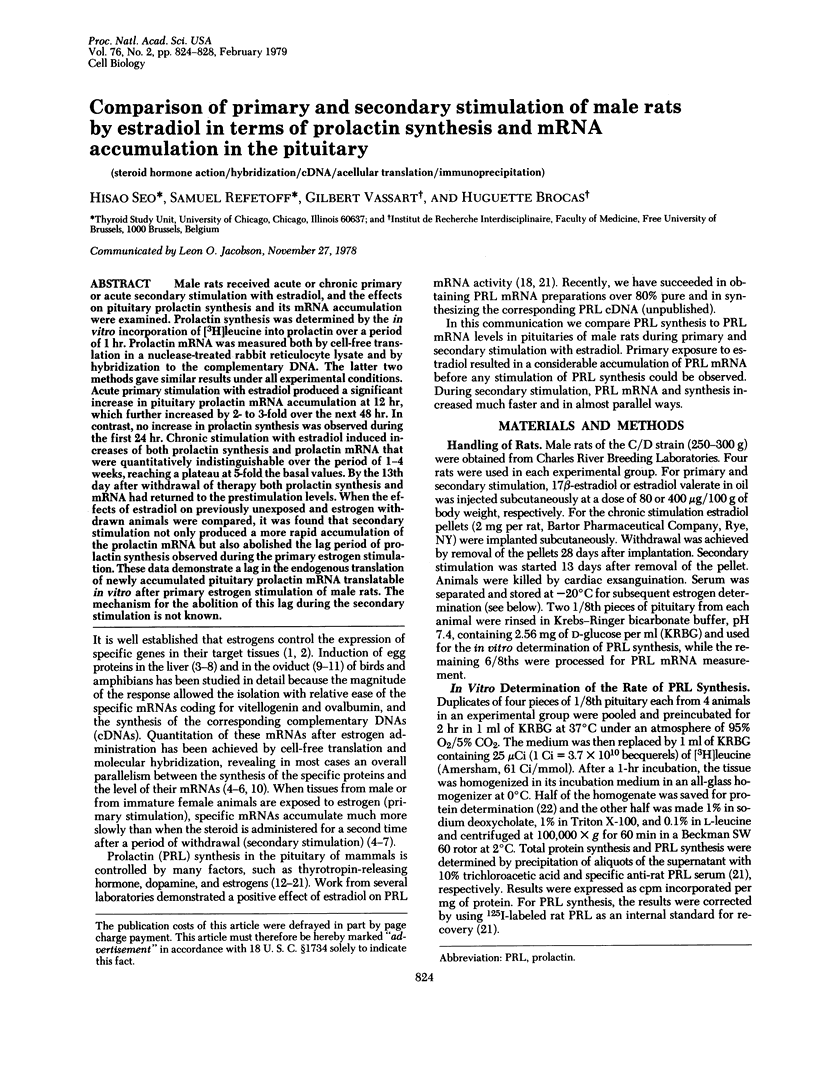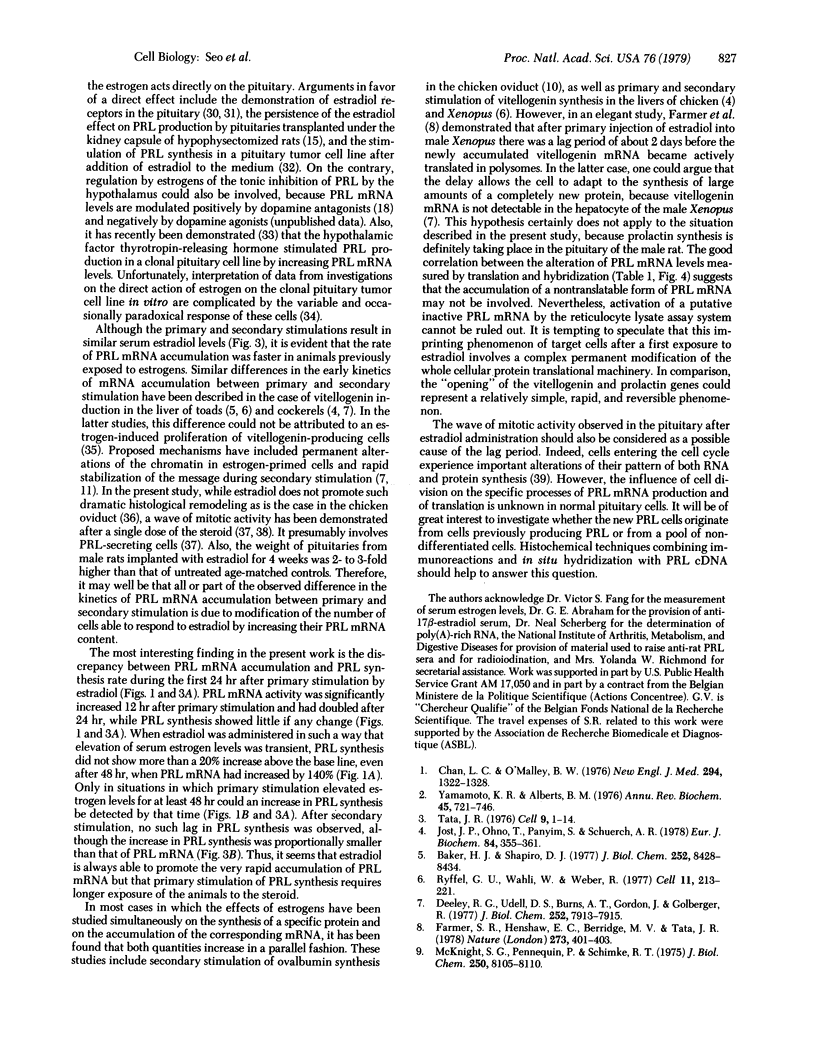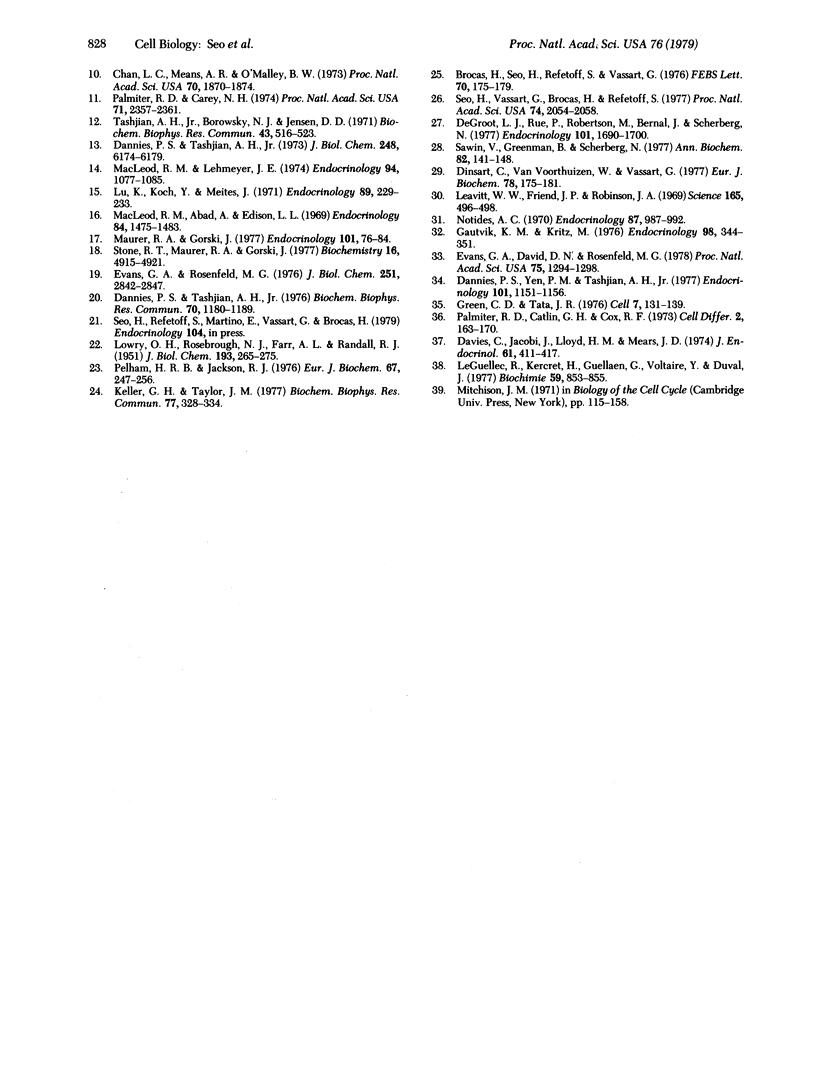Abstract
Male rats received acute or chronic primary or acute secondary stimulation with estradiol, and the effects on pituitary prolactin synthesis and its mRNA accumulation were examined. Prolactin synthesis was determined by the in vitro incorporation of [3H]leucine into prolactin over a period of 1 hr. Prolactin mRNA was measured both by cell-free translation in a nuclease-treated rabbit reticulocyte lysate and by hybridization to the complementary DNA. The latter two methods gave similar results under all experimental conditions. Acute primary stimulation with estradiol produced a significant increase in pituitary prolactin mRNA accumulation at 12 hr, which further increased by 2- to 3-fold over the next 48 hr. In contrast, no increase in prolactin synthesis was observed during the first 24 hr. Chronic stimulation with estradiol induced increases of both prolactin synthesis and prolactin mRNA that were quantitatively indistinguishable over the period of 1-4 weeks, reaching a plateau at 5-fold the basal values. By the 13th day after withdrawal of therapy both prolactin synthesis and mRNA had returned to the prestimulation levels. When the effects of estradiol on previously unexposed and estrogen withdrawn animals were compared, it was found that secondary stimulation not only produced a more rapid accumulation of the prolactin mRNA but also abolished the lag period of prolactin synthesis observed during the primary estrogen stimulation. These data demonstrate a lag in the endogenous translation of newly accumulated pituitary prolactin mRNA translatable in vitro after primary estrogen stimulation of male rats. The mechanism for the abolition of this lag during the secondary stimulation is now known.
Keywords: steroid hormone action, hybridization, cDNA, acellular translation, immunoprecipitation
Full text
PDF




Selected References
These references are in PubMed. This may not be the complete list of references from this article.
- Baker H. J., Shapiro D. J. Kinetics of estrogen induction of Xenopus laevis vitellogenin messenger RNA as measured by hybridization to complementary DNA. J Biol Chem. 1977 Dec 10;252(23):8428–8434. [PubMed] [Google Scholar]
- Brocas H., Seo H., Refetoff S., Vassart G. Simultaneous translation of growth hormone and prolactin messenger RNA from rat pituitary tumor cells. FEBS Lett. 1976 Nov;70(1):175–179. doi: 10.1016/0014-5793(76)80752-1. [DOI] [PubMed] [Google Scholar]
- Chan L., Means A. R., O'Malley B. W. Rates of induction of specific translatable messenger RNAs for ovalbumin and avidin by steroid hormones. Proc Natl Acad Sci U S A. 1973 Jun;70(6):1870–1874. doi: 10.1073/pnas.70.6.1870. [DOI] [PMC free article] [PubMed] [Google Scholar]
- Chan L., O'Malley B. W. Mechanism of action of the sex steroid hormones (first of three parts). N Engl J Med. 1976 Jun 10;294(24):1322–1328. doi: 10.1056/NEJM197606102942405. [DOI] [PubMed] [Google Scholar]
- Dannies P. S., Tashjian A. H., Jr Thyrotropin-releasing hormone increases prolactin mRNA activity in the cytoplasm of GH-cells as measured by translation in a wheat germ cell-free system. Biochem Biophys Res Commun. 1976 Jun 21;70(4):1180–1189. doi: 10.1016/0006-291x(76)91027-5. [DOI] [PubMed] [Google Scholar]
- Dannies P. S., Tashjian A. R., Jr Effects of thyrotropin-releasing hormone and hydrocortisone on synthesis and degradation of prolactin in a rat pituitary cell strain. J Biol Chem. 1973 Sep 10;248(17):6174–6179. [PubMed] [Google Scholar]
- Dannies P. S., Yen P. M., Tashijian A. H., Jr Anti-estrogenic compounds increase prolactin and growth hormone synthesis in clonal strains of rat pituitary cells. Endocrinology. 1977 Oct;101(4):1151–1156. doi: 10.1210/endo-101-4-1151. [DOI] [PubMed] [Google Scholar]
- Davies C., Jacobi J., Lloyd H. M., Meares J. D. DNA synthesis and the secretion of prolactin and growth hormone by the pituitary gland of the male rat: effects of diethylstilboestrol and 2-bromo-alpha-ergocryptine methanesluphonate. J Endocrinol. 1974 Jun;61(3):411–417. doi: 10.1677/joe.0.0610411. [DOI] [PubMed] [Google Scholar]
- DeGroot L. J., Rue P., Robertson M., Bernal J., Scherberg N. Triiodothyronine stimulates nuclear RNA synthesis. Endocrinology. 1977 Dec;101(6):1690–1700. doi: 10.1210/endo-101-6-1690. [DOI] [PubMed] [Google Scholar]
- Deeley R. G., Udell D. S., Burns A. T., Gordon J. I., Goldberger R. F. Kinetics of avian vitellogenin messenger RNA induction. Comparison between primary and secondary response to estrogen. J Biol Chem. 1977 Nov 25;252(22):7913–7915. [PubMed] [Google Scholar]
- Dinsart C., Van Voorthuizen F., Vassart G. Reverse transcription of thyroglobulin 33-S mRNA. Eur J Biochem. 1977 Aug 15;78(1):175–181. doi: 10.1111/j.1432-1033.1977.tb11727.x. [DOI] [PubMed] [Google Scholar]
- Evans G. A., David D. N., Rosenfeld M. G. Regulation of prolactin and somatotropin mRNAs by thyroliberin. Proc Natl Acad Sci U S A. 1978 Mar;75(3):1294–1298. doi: 10.1073/pnas.75.3.1294. [DOI] [PMC free article] [PubMed] [Google Scholar]
- Evans G. A., Rosenfeld M. G. Cell-free synthesis of a prolactin precursor directed by mRNA from cultured rat pituitary cells. J Biol Chem. 1976 May 10;251(9):2842–2847. [PubMed] [Google Scholar]
- Farmer S. R., Henshaw E. C., Berridge M. V., Tata J. R. Translation of Xenopus vitellogenin mRNA during primary and secondary induction. Nature. 1978 Jun 1;273(5661):401–403. doi: 10.1038/273401a0. [DOI] [PubMed] [Google Scholar]
- Gautvik K. M., Kriz M. Measurements of prolactin and growth hormone synthesis and secretion by rat pituitary cells in culture. Endocrinology. 1976 Feb;98(2):344–351. doi: 10.1210/endo-98-2-344. [DOI] [PubMed] [Google Scholar]
- Green C. D., Tata J. R. Direct induction by estradiol on vitellogenin synthesis in organ cultures of male Xenopus laevis liver. Cell. 1976 Jan;7(1):131–139. doi: 10.1016/0092-8674(76)90263-4. [DOI] [PubMed] [Google Scholar]
- Jost J. P., Ohno T., Panyim S., Schuerch A. R. Appearance of vitellogenin mRNA sequences and rate of vitellogenin synthesis in chicken liver following primary and secondary stimulation by 17 beta-estradiol. Eur J Biochem. 1978 Mar 15;84(2):355–361. doi: 10.1111/j.1432-1033.1978.tb12175.x. [DOI] [PubMed] [Google Scholar]
- Keller G. H., Taylor J. M. Synthesis of a complementary DNA to rat liver albumin mRNA. Biochem Biophys Res Commun. 1977 Jul 11;77(1):328–334. doi: 10.1016/s0006-291x(77)80200-3. [DOI] [PubMed] [Google Scholar]
- LOWRY O. H., ROSEBROUGH N. J., FARR A. L., RANDALL R. J. Protein measurement with the Folin phenol reagent. J Biol Chem. 1951 Nov;193(1):265–275. [PubMed] [Google Scholar]
- Le Guellec R., Kercret H., Guellaen G., Volataire Y., Duval J. Oestrogènes et multiplication cellulaire dans l'adénohypophyse du rat mâle : études in vivo et in vitro. Biochimie. 1977;59(10):853–855. doi: 10.1016/s0300-9084(77)80218-6. [DOI] [PubMed] [Google Scholar]
- Leavitt W. W., Friend J. P., Robinson J. A. Estradiol: specific binding by pituitary nuclear fraction in vitro. Science. 1969 Aug 1;165(3892):496–498. doi: 10.1126/science.165.3892.496. [DOI] [PubMed] [Google Scholar]
- Lu K. H., Koch Y., Meites J. Direct inhibition by ergocornine of pituitary prolactin release. Endocrinology. 1971 Jul;89(1):229–233. doi: 10.1210/endo-89-1-229. [DOI] [PubMed] [Google Scholar]
- MacLeod R. M., Abad A., Eidson L. H. In vivo effect of sex hormones on the in vitro synthesis of prolactin and growth hormone in normal and pituitary tumor-bearing rats. Endocrinology. 1969 Jun;84(6):1475–1483. doi: 10.1210/endo-84-6-1475. [DOI] [PubMed] [Google Scholar]
- MacLeod R. M., Lehmeyer J. E. Studies on the mechanism of the dopamine-mediated inhibition of prolactin secretion. Endocrinology. 1974 Apr;94(4):1077–1085. doi: 10.1210/endo-94-4-1077. [DOI] [PubMed] [Google Scholar]
- Maurer R. A., Gorski J. Effects of estradiol-17beta and pimozide on prolactin synthesis in male and female rats. Endocrinology. 1977 Jul;101(1):76–84. doi: 10.1210/endo-101-1-76. [DOI] [PubMed] [Google Scholar]
- McKnight G. S., Pennequin P., Schimke R. T. Induction of ovalbumin mRNA sequences by estrogen and progesterone in chick oviduct as measured by hybridization to complementary DNA. J Biol Chem. 1975 Oct 25;250(20):8105–8110. [PubMed] [Google Scholar]
- Notides A. C. The binding affinity and specificity of the estrogen receptor of the rat uterus and anterior pituitary. Endocrinology. 1970 Nov;87(5):987–992. doi: 10.1210/endo-87-5-987. [DOI] [PubMed] [Google Scholar]
- Palmiter R. D., Carey N. H. Rapid inactivation of ovalbumin messenger ribonucleic acid after acute withdrawal of estrogen. Proc Natl Acad Sci U S A. 1974 Jun;71(6):2357–2361. doi: 10.1073/pnas.71.6.2357. [DOI] [PMC free article] [PubMed] [Google Scholar]
- Palmiter R. D., Catlin G. H., Cox R. F. Chromatin-associated receptors for estrogen, progesterone, and dihydrotestosterone and the induction of egg white protein synthesis in chick magnum. Cell Differ. 1973 Jul;2(3):163–170. doi: 10.1016/0045-6039(73)90017-1. [DOI] [PubMed] [Google Scholar]
- Pelham H. R., Jackson R. J. An efficient mRNA-dependent translation system from reticulocyte lysates. Eur J Biochem. 1976 Aug 1;67(1):247–256. doi: 10.1111/j.1432-1033.1976.tb10656.x. [DOI] [PubMed] [Google Scholar]
- Ryffel G. U., Wahli W., Weber R. Quantitation of vitellogenin messenger RNA in the liver of male Xenopus toads during primary and secondary stimulation by estrogen. Cell. 1977 May;11(1):213–221. doi: 10.1016/0092-8674(77)90332-4. [DOI] [PubMed] [Google Scholar]
- Sawin V., Greenman B., Scherberg N. A new radiochemical method for detecting poly(A)-RNA. Anal Biochem. 1977 Sep;82(1):141–148. doi: 10.1016/0003-2697(77)90142-7. [DOI] [PubMed] [Google Scholar]
- Seo H., Vassart G., Brocas H., Refetoff S. Triiodothyronine stimulates specifically growth hormone mRNA in rat pituitary tumor cells. Proc Natl Acad Sci U S A. 1977 May;74(5):2054–2058. doi: 10.1073/pnas.74.5.2054. [DOI] [PMC free article] [PubMed] [Google Scholar]
- Stone R. T., Maurer R. A., Gorski J. Effect of estradiol-17 beta on preprolactin messenger ribonucleic acid activity in the rat pituitary gland. Biochemistry. 1977 Nov 1;16(22):4915–4921. doi: 10.1021/bi00641a027. [DOI] [PubMed] [Google Scholar]
- Tashjian A. H., Jr, Barowsky N. J., Jensen D. K. Thyrotropin releasing hormone: direct evidence for stimulation of prolactin production by pituitary cells in culture. Biochem Biophys Res Commun. 1971 May 7;43(3):516–523. doi: 10.1016/0006-291x(71)90644-9. [DOI] [PubMed] [Google Scholar]
- Tata J. R. The expression of the vitellogenin gene. Cell. 1976 Sep;9(1):1–14. doi: 10.1016/0092-8674(76)90047-7. [DOI] [PubMed] [Google Scholar]
- Yamamoto K. R., Alberts B. M. Steroid receptors: elements for modulation of eukaryotic transcription. Annu Rev Biochem. 1976;45:721–746. doi: 10.1146/annurev.bi.45.070176.003445. [DOI] [PubMed] [Google Scholar]


